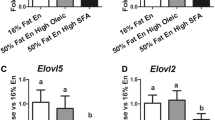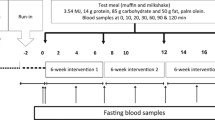Abstract
This study was designed to examine the effects of dietary n−3 and n−6 polyunsaturated fatty acids (PUFA) on postprandial lipid levels and fatty acid composition of hepatic membranes. Male Sprague-Dawley rats were trained for a 3−h feeding protocol and fed one of five semipurified diets: one fat-free diet or one of four diets supplemented with 10% (by weight) each of corn oil, beef tallow, perilla oil, and fish oil. Two separate experiments were performed, 4-wk long-term and 4-d short-term feeding models, to compare the effects of feeding periods. Postprandial plasma lipid was affected by dietary fats. Triacylglycerol (TG) and total cholesterol levels were decreased in rats fed perilla oil and fish oil diets compared with corn oil and beef tallow diets. Hepatic TG and total cholesterol levels were also reduced by fish oil and perilla oil diets. Fatty acid composition of hepatic microsomal fraction reflected dietary fatty acids and their metabolic conversion. The major fatty acids of rats fed the beef tallow diet were palmitic, stearic, and oleic. Similarly, linoleic acid (LA) and arachidonic acid in the corn oil group, α-linolenic acid (ALA) and eicosapentaenoic acid (EPA) in the perilla oil group, and palmitic acid and docosahexaenoic acid (DHA) in the fish oil group were detected in high proportions. Both long- and short-term feeding experiments showed similar results. In addition, microsomal DHA content was negatively correlated with plasma lipid levels. Hepatic lipid levels were also negatively correlated with EPA and DHA contents. These results suggest that n−3 ALA has more of a hypolipidemic effect than n−6 LA and that the hypolipidemic effect of n−3 PUFA may be partly related to the increase of EPA and DHA in hepatic membrane.
Similar content being viewed by others
Abbreviations
- AA:
-
arachidonic acid
- ALA:
-
α-linolenic acid
- BT:
-
beef tallow
- CO:
-
corn oil
- DHA:
-
docosahexaenoic acid
- EPA:
-
eicosapentaenoic acid
- FF:
-
fat free
- FO:
-
fish oil
- HDL-C:
-
high density lipoprotein-cholesterol
- LA:
-
linoleic acid
- PO:
-
perilla oil
- PUFA:
-
polyunsaturated fatty acid
- TC:
-
total cholesterol
- TG:
-
triacylglycerol
References
Jeppesen, J., Hein, H.O., Suadicani, P., and Gyntelberg, F. (1998) Triglyceride Concentration and Ischemic Heart Disease. An Eight-Year Follow-Up in the Copenhagen Male Study, Circulation 97, 1029–1036.
Stamler, J., Wentworth, D., and Neaton, J.D. (1986) Is Relationship Between Serum Cholesterol and Risk of Premature Death from Coronary Heart Disease Continuous and Graded? J. Am. Med. Assoc. 256, 2823–2828.
Kestin, M., Clifton, P., Bellin, G.B., and Nestel, P.J. (1990) n−3 Fatty Acids of Marine Origin Lower Systolic Blood Pressure and Triglycerides but Raise LDL-Cholesterol Compared with n−3 and n−6 Fatty Acids from Plants, Am. J. Clin. Nutr. 51, 1028–1034.
Groot, P.H., van Stiphout, W.A., Krauss, X.H., Jansen, H., van Tol, A., van Ramshorst, E., Chin-On, S., Hofman, A., Cresswell, S.R., and Havekes, L. (1991) Postprandial Lipoprotein Metabolism in Normolipidemic Men With and Without Coronary Artery Disease, Arterioscler. Thromb. 11, 653–662.
Uiterwaal, C.S., Grobbee, D.E., Witteman, J.C., van Stiphout, W.A., Krauss, X.H., Havekes, L.M., de Bruijn, A.M., van Tol, A., and Hofman, A. (1994) Postprandial Triglyceride Response in Young Adult Men and Familial Risk for Coronary Atherosclerosis, Ann. Intern. Med. 121, 576–583.
Zilversmit, D.B. (1995) Atherogenic Nature of Triglycerides, Postprandial Lipidemia, and Triglyceride-Rich Remnant Lipoproteins, Clin. Chem. 41, 153–158.
Harris, W.S. (1993) Fish Oil Reduces Postprandial Triglyceride Concentrations Without Accelerating Lipid-Emulsion Removal Rates, Am. J. Clin. Nutr. 58, 68–74.
Harris, W.S., Connor, W.E., Alam, N., and Illingworth, D.R. (1988) Reduction of Postprandial Triglyceridemia in Humans by Dietary n−3 Fatty Acids, J. Lipid Res. 29, 1451–1460.
Weintraub, M.S., Zechner, R., Brown, A., Elsenberg, S., and Breslow, J.L. (1988) Dietary Polyunsaturated Fats of the ω-6 and ω-3 Series Reduce Postprandial Lipoprotein Levels, J. Clin. Invest. 82, 1884–1893.
Williams, C.M., Moore, F., Morgan, L., and Wright, J. (1992) Effects of n−3 Fatty Acids on Postprandial Triacylglycerol and Hormone Concentrations in Normal Subjects, Br. J. Nutr. 68, 655–666.
Stubbs, C.D., and Smith, A.D. (1984) The Modification of Mammalian Polyunsaturated Fatty Acid Composition in Relation to Membrane Fluidity and Function, Biochim. Biophys. Acta 779, 89–137.
Strum-Odin, R., Adkins-Finke, B., Blake, W.L., Phinney, S.D., and Clarke, S.D. (1987) Modification of Fatty Acid Composition of Membrane Phospholipid in Hepatocyte Monolayer with n−3, n−6 and n−9 Fatty Acids and Its Relationship to Triglycerol Production, Biochim. Biophys. Acta 921, 378–391.
Huang, Y.S., and Nassar, B.A. (1990) Modulation of Tissue Fatty Acid Composition, Prostaglandin Production and Cholesterol Levels by Dietary Manipulation of n−3 and n−6 Essential Fatty Acid Metabolites, in Omega-6 Essential Fatty Acids, Pathophysiology and Roles in Clinical Medicines (Horrobin, D.F., ed.), pp. 127–144, Alan R. Liss Inc., New York.
Witting, L.A. (1974) Vitamin E-Polyunsaturated Lipid Relationship in Diet and Tissues, Am. J. Clin. Nutr. 27, 952–959.
Folch, J., Lees, M., and Sloane-Stanley, G.H. (1957) A Simple Method for the Isolation and Purification of Total Lipids from Animal Tissue, J. Biol. Chem. 226, 497–509.
Lepage, G., and Roy, C.C. (1986) Direct Transesterification of All Classes of Lipids in a One-Step Reaction, J. Lipid Res. 27, 114–120.
Agren, J.J., Hanninen, O., Julkunen, A., Figelholm, L., Vidgren, H., Schwab, U., Pynnonen, O., and Uusitupa, M. (1996) Fish Diet, Fish Oil and Docosahexaenoic Acid Rich Oil Lower Fasting and Postprandial Plasma Lipid Levels, Eur. J. Clin. Nutr. 50, 765–771.
Sanders, T.A., Oakley, F.R., Miller, G.J., Mitropoulos, K.A., Crook, D., and Oliver, M.F. (1997) Influence of n−6 versus n−3 Polyunsaturated Fatty Acids in Diets Low in Saturated Fatty Acids on Plasma Lipoproteins and Hemostatic Factors, Arterioscler. Thromb. Vasc. Biol. 17, 3449–3460.
Tinker, L.F., Parks, E.J., Behr, S.R., Schneeman, B.O., and Davis, P.A. (1999) (n−3) Fatty Acid Supplementation in Moderately Hypertriglyceridemic Adults Changes Postprandial Lipid and Apolipoprotein B Responses to a Standardized Test Meal, J. Nutr. 129, 1126–1134.
Parks, J.S., and Rudel, L.L. (1990) Effect of Fish Oil on Atherosclerosis and Lipoprotein Metabolism, Atherosclerosis 84, 83–94.
Ihara, M., Umekawa, H., Takahashi, T., and Furuichi, Y. (1998) Comparative Effects of Short-and Long-Term Feeding of Safflower Oil and Perilla Oil on Lipid Metabolism in Rats, Comp. Biochem. Physiol. B. Biochem. Mol. Biol. 121, 223–231.
Sanz, M., Lopez-Bote, C.J., Menoyo, D., and Bautista, J.M. (2000) Abdominal Fat Deposition and Fatty Acid Synthesis Are Lower and β-Oxidation Is Higher in Broiler Chickens Fed Diets Containing Unsaturated Rather Than Saturated Fat, J. Nutr. 130, 3034–3037.
Fumeron, F., Brigant, L., Parra, H.J., Bard, J.M., Fruchart, J.C., and Apfelbaum, M. (1991) Lowering of HDL2-Cholesterol and Lipoprotein A-1 Particle Levels by Increasing the Ratio of Polyunsaturated to Saturated Fatty Acids, Am. J. Clin. Nutr. 53, 655–659.
Woolet, L. A., Spady, D.K., and Dietschy, J.M. (1992) Saturated and Unsaturated Fatty Acids Independently Regulate Low Density Lipoprotein Receptor Activity and Production Rate, J. Lipid Res. 33, 77–88.
Benhizia, F., Hainault, I., Serougne, C., Lagrange, D., Hajduch, E., Guichard, C., Malewial, M., Boulange, A.Q., Lavau, M., and Griglio, S. (1994) Effects of Fish Oil-Lard Diet on Rat Plasma Lipoproteins, Liver FAS, and Lipolytic Enzymes, Am. J. Physiol. 267, E975-E982.
Avers, C.J. (1986) Endoplasmic Reticulum and Golgi Apparatus, in Molecular Cell Biology, pp. 227–266, Addison Wesley, Reading.
Bernasconi, A.M., Garda, H.A., and Brenner, R.R. (2000) Dietary Cholesterol Induces Changes in Molecular Species of Hepatic Microsomal Phosphatidylcholine, Lipids 35, 1335–1344.
Mahfouz, M.M., Smith, T.L., and Kummerow, F.A. (1984) Effect of Dietary Fats on Desaturase Activities and the Biosynthesis of Fatty Acids in Rat-Liver Microsomes, Lipids 19, 214–222.
Hwang, D.H., Boudreau, M., and Chanmugam, P. (1988) Dietary Linolenic Acid and Longer-Chain n−3 Fatty Acid: Comparison of Effects on Arachidonic Acid Metabolism in Rats, J. Nutr. 118, 427–437.
Weber, P. (1999) Triglyceride-Lowering Effect of n−3 Long Chain Polyunsaturated Fatty Acid: Eicosapentaenoic Acid vs. Docosahexaenoic Acid, Lipids 34, S269.
Clandinin, M.T., Cheema, S., Field, C.J., Garg, M.L., Venkatraman, J., and Clandinin, T.R. (1991) Dietary Fat: Exogenous Determination of Membrane Structure and Cell Function, FASEB J., 5, 2761–2769.
Yang, E.K., Radominska, A., Winder, B.S., and Dannenberg, A.J. (1993) Dietary Lipids Coinduce Xenobiotic Metabolizing Enzymes in Rat Liver, Biochim. Biophys. Acta 1168, 52–58.
Author information
Authors and Affiliations
Corresponding author
About this article
Cite this article
Kim, HK., Choi, H. Dietary α-linolenic acid lowers postprandial lipid levels with increase of eicosapentaenoic and docosahexaenoic acid contents in rat hepatic membrane. Lipids 36, 1331–1336 (2001). https://doi.org/10.1007/s11745-001-0849-7
Received:
Revised:
Accepted:
Issue Date:
DOI: https://doi.org/10.1007/s11745-001-0849-7




